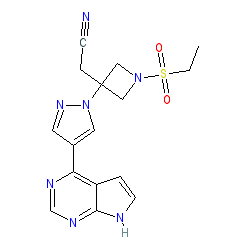|
Synonyms: INCB-028050 | INCB028050 | LY-3009104 | LY3009104 | Olumiant®
baricitinib is an approved drug (EMA (2017), FDA (2018))
Compound class:
Synthetic organic
Comment: Baricitinib is a JAK1 and 2 selective inhibitor. The compound is orally bioavailable.
SARS-CoV-2 and COVID-19: The powerful anti-inflammatory activity of baricitinib (and potentially other approved JAK inhibitors such as fedratinib, and ruxolitinib) was suggested as potential therapeutic option to combat the immunopathological effects of SARS-CoV-2 infection in patients with severe COVID-19. A number of small-medium sized clinical studies have examined the effect of short-term baricitinib (or other JAK inhibitors) treatment in hospitalised patients with confirmed COVID-19. Such short term use of this drug during the course of SARS-CoV-2 infection (7-14 days) is not anticipated to cause serious side-effects. In March 2022, data reported from the largest of the baricitinib studies (part of the University of Oxford-led RECOVERY trial) indicated that it provided clinical benefit in hospitalised COVID-19 patients, including in those already receiving other standard care immunomodulatory treatments (e.g. dexamethasone, tocilizumab) or the antiviral drug remdesivir. This made baricitinib the 4th effective COVID-19 therapy to be identified by the RECOVERY trial. Through the application of proprietary artificial intelligence (AI) algorithms baricitinib was predicted to possess antiviral activity in addition to its known anti-inflammatory efficacy [1,9-10]. Antiviral activity is predicted to arise from inhibition of the numb-associated kinase (NAK) AAK1 which is an important regulator of clathrin-mediated endocytosis. Inhibition of AAK1 would likely reduce the ability of viruses to infect lung cells, and is being proposed as a pharmacological mechanism that warrants further investigation as a treatment for SARS-CoV-2 infection. Ligand Activity Visualisation ChartsThese are box plot that provide a unique visualisation, summarising all the activity data for a ligand taken from ChEMBL and GtoPdb across multiple targets and species. Click on a plot to see the median, interquartile range, low and high data points. A value of zero indicates that no data are available. A separate chart is created for each target, and where possible the algorithm tries to merge ChEMBL and GtoPdb targets by matching them on name and UniProt accession, for each available species. However, please note that inconsistency in naming of targets may lead to data for the same target being reported across multiple charts. ✖ |
|
|||||||||||||||||||||||||||||||||||
| Immunopharmacology Comments |
| Baricitinib-induced inhibition of JAKs 1 and 2, down-modulates the intracellular signalling that is induced by multiple proinflammatory cytokines, including IL-6 and IL-23 that are elevated in patients with autoimmune diseases. This action evokes an improvement in clinical measures of autoinflammatory diseases. Unfortunately, baricitinib causes adverse events (thrombosis and elevated platelet counts) that don't appear to be common to other JAK inhibitors that are in development, for example the JAK1-selective inhibitors upadacitinib and filgotinib, which suggests that inhibition of JAK2 may be the culprit. Note that as immunosuppressants, all currently marketed JAK inhibitor class drugs (ruxolitinib and tofacitinib for human treatment) pose the risk of serious side-effects, such as increased risk of serious infection or malignancy. This risk is exemplified by the boxed warning on the package insert for Pfizer's JAK3-selective inhibitor tofacitinib (Xeljanz®). |
| Immunopharmacology Disease | |||
| Disease | X-Refs | Comment | References |
| Alopecia areata |
Disease Ontology:
DOID:986 |
Baricitinib is approved by the FDA as a treatment for severe alopecia areata | |
| Rheumatoid arthritis |
Disease Ontology:
DOID:7148 OMIM: 180300 |
Approved drug for moderate to severe RA. | |









